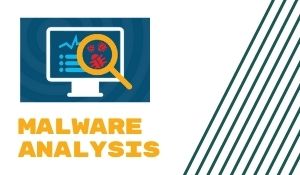
BRIEF ON MALWARE ANALYSIS
With the development and spread of information technologies in recent years, malware has begun to manifest itself as a widespread threat that can have an effect on large networks rather than being confined to small attacks. As long as the Internet and its connected devices are used, there is the possibility of encountering malicious software every day. And while end-user awareness is increasing in the fight against malware, it is no longer sufficient to stop malware production and attackers who use malicious software because of vulnerabilities found in systems, errors in the software used and connected networks, and subsequent security vulnerabilities.
The purpose of malware analysis is to find out about a program’s behavior and verify if it has malicious functionality or behavior. If the analyzed pattern is found to be malicious, then its classification and identification of which malware family it belongs to are necessary.
Malware analysis is a process analyzing the samples of malware families such as Trojans, viruses, rootkits, ransomware, and spyware in an isolated environment to understand the infection, type, purpose, and performance through applying the various methods primarily based on its behavior to understanding the motivation and applying the appropriate mitigation via creating guidelines and signatures to prevent the users. The open-source malware analysis tools are Cuckoo Sandbox, Yara Rules, Google Rapid Response (GRR), Remnux, and Bro.
Organizations are facing problems, and the cause is unknown, and many of them do not even know the source of infection or anti-viruses are used to detect problems. The main hassle with them is they do not canalize files, i.e., they can’t notice viruses, backdoors, or rootkits that are custom-crafted. Anti-viruses or anti-malware software have databases and signatures that are used to scan for viruses, but a newly developed virus is not detected, and therefore it is required to manually analyze viruses and malware.
| Learn more information from the GoLogica “Cyber security Masters Program“ |
ADVANCEMENTS IN MALWARE
Although malicious software (malware) has been around since the early days of computers, the sophistication and innovation of malware have increased over the years. The costs associated with ransomware damage are expected to attain $8 billion in 2018. Although 94% of the organizations that have suffered a ransomware attack did not pay the ransom, the harm caused through data loss and the number of man-hours required to mitigate the infection can be significant.
Malware attacks have even started to affect embedded computing platforms such as Internet of Things (IoT) devices, medical equipment, and environmental and industrial control systems. Instead of relying on traditional defense mechanisms, typically comprising the use of signature-based techniques, there is a need to have a broader spectrum of techniques to deal with the diverse nature of malware. The editions of malware families share typical behavioral patterns that can be obtained either statically or dynamically. Machine learning methods can take advantage of such static and behavioral artifacts to model the evolving structure of modern malware, consequently enabling the detection of more complex malware attacks that cannot be easily detected through standard signature-based methods. Non Reliance on signatures makes machine-learning-based techniques more effective for newly released malware. Moreover, the feature extraction and representation method can further be improved by using deep learning algorithms that can implicitly perform feature engineering.
FUTURE ASPECTS ON MALWARE ANALYSIS
Malware analysis is one of the most sought-after cyber security methodologies. With different job opportunities advertised on a day-to-day basis. Malware analysts have a competitive advantage over many other cybersecurity jobs because being an analyst takes different programming and language skills as well as a robust understanding of complex tools. It is considered through most to be an experienced-level, rather than an entry-level, role and commands a commensurate level of compensation. While some researchers indicate an average annual salary of around $100,000, according to a recent finding by Neuvoo.com, the average malware analyst salary in the USA is $165,000 per year. Entry-level positions start at $78,000 annually, while experienced workers can make up to $234,000 annually.
Gologica Malware Analysis Course is for Beginners as well as for skilled professionals. This course would open up a number of career opportunities. People working in cyber security and ethical hacking taking up this course would be an excellent career boost.
Related Articles :
- 🎯 Enhance your skills with Commvault Technology
- 🎯 Top 15 Reasons to Learn Cybersecurity in 2025
- 🎯 Malware Analysis Interview Questions Updated 2025
- 🎯 Ethical Hacking Important Interview Questions And Answers
- 🎯 Cyberoam Admin Most Common Interview Questions And Answers
- 🎯 ArcSight Interview Questions And Answers
- 🎯CompTIA Best Interview Questions And Answers
- 🎯 Commvault Interview Questions and Answers
- 🎯 Cyber Security Interview Questions and Answers
- 🎯 Forgerock OpenAM tutorial updated 2025
- 🎯 Cyber Security Tutorial for Beginners
- 🎯Comparison of Okta, ForgeRock and Cyber Security












